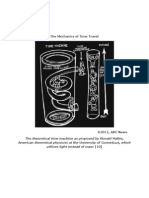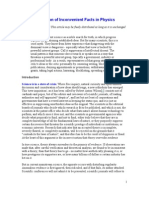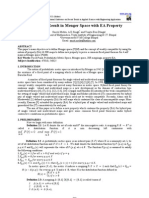Introduction To Theorethical Time Travel
Introduction To Theorethical Time Travel
Uploaded by
juanramonchoCopyright:
Available Formats
Introduction To Theorethical Time Travel
Introduction To Theorethical Time Travel
Uploaded by
juanramonchoOriginal Title
Copyright
Available Formats
Share this document
Did you find this document useful?
Is this content inappropriate?
Copyright:
Available Formats
Introduction To Theorethical Time Travel
Introduction To Theorethical Time Travel
Uploaded by
juanramonchoCopyright:
Available Formats
archived as http://www.stealthskater.com/Documents/Time_1.doc [pdf] more on time-travel at http://www.stealthskater.com/Science.htm and http://www.stealthskater.com/PX.
htm
Introduction to Theoretical Time Travel
from Time
Life books
Time-Travel is easy. All of us do it every day. But only in one direction. For thousands of years, scientists and philosophers have talked of time as a "river that flows steadily onward year-after-year". But what if there were a way to swim against the flow? Or to run down the bank ahead of the river? Might we might be able to journey back-and-forth in time just as we travel through space. The idea is not as far-fetched as it sounds. And the implications for the future are intriguing. 1895 1905 British author H.G. Wells publishes The Time Machine Albert Einstein's Special Theory of Relativity shows that space and time are "relative" -- not absolute -- and that time is actually a 4th dimension within what he calls "spacetime". Einstein discovers that space-time is curved. Mathematician Kurt Goedel proposes that the Universe itself may be a time machine. Goedel demonstrates mathematically that pathways through time are possible. U.S. physicist John Wheeler invents the name "black hole" to describe singularities in space and time. (Wheeler also co-developed the Everett/Wheeler 'Many Worlds' quantum-based theory of parallel universes and time lines.) Astrophysicist Frank Tipler plots paths around a vast, imaginary spinning cylinder, confirming that paths though time can exist! The movie "Back to the Future" is released. Caltech University's Kip Thorne (in a reply to Carl Sagan who was writing his novel "Contact") proves that under the right conditions, "wormholes" can be used as a possible means of time-travel. Richard Gott at Princeton University proves that "cosmic strings" could be used for time travel.
1916 1937 1949 1967
1974 1985 1988
1991
Super-Science , NOT Fantasy!
Ever since Einstein, scientists have considered time and 3-dimensional space not as 2 different things but as different aspects of a 4-dimensional "space-time". Quantum physicists(who study the world of subatomic particles) often find it easier to explain events by assuming time runs backward as well as forward despite however much it defies common sense. At the other extreme, cosmologists looking at the Universe on a grand scale have found that space and time can be warped by gravity and speed. Back in the 1940s, German mathematician Kurt Goedel proved that if we could warp and twist space-time enough -- creating what he called "Closed, Time-like Curves (CTC)" -- then we could bore tunnels through time itself. But no one knew how to do the twisting. Until black holes. The gravitational pull of a black hole is so enormous that it distorts the very fabric of space-time into what is called a singularity. When singularities were found to spin, it was proved that Closed, Time1
like Curves not only can occur -- they MUST occur! The singularity forms a doughnut shape in spacetime while the hole in the middle is a perilous gateway to somewhere -- or when. [StealthSkater note: while the implications to CTCs may still be preserved, newer models of black holes offer a Gravastar to replace the point-like singularity of infinite density. For further information, go to doc pdf URL ]
3 Ways to Travel in Time Without Breaking the Rules
1. Wormholes Since the 1930s, physicists have speculated about the existence of "wormholes" in the fabric of space. Wormholes are essentially gateway between different parts of the Universe and are made by linking a pair of black holes. This effectively creates a tunnel through time and space: a traveler entering at one end would exit the other at a different time as well as a different place. The difficulty likes in keeping the wormhole open while the traveler makes his journey. If the opening snaps shut, he will never survive to emerge at the other end. For years, scientists believed that the transit was physically impossible. But recent research -- especially the U.S. physicist Kip Thorne -- suggest that it could be done using exotic materials capable of withstanding the immense forces involved. Even then, the time machine would be of limited use. For example, you could not return to a time before the wormhole was created. Using wormhole technology would also require a society so technologically advanced that it could master and exploit the energy within black holes. But the trip would NOT be impossible -- just very, very difficult! 2. Rotating Cylinder Civilizations with the technology to harness black holes might be better advised to leave wormholes and try the time-warp method suggested by U.S. astronomer Frank Tipler. He has a simple recipe for a time machine. First, take a piece of material 10 times the mass of the Sun. Then squeeze it together and roll it into a long, thin, super-dense cylinder (a bit like a black hole that has passed through a spaghetti factor). Lastly, spin this cylinder at a few billion revolutionsper-minute and see what happens. Tipler predicts that a ship following a carefully plotted spiral course around the cylinder would immediately find itself on a "Closed, Time-like Curve". It would emerge thousand -- even billions -- of years from its starting point and possibly several galaxies away. There are problems, though. For the mathematics to work properly, Tipler's cylinder has to be infinitely long. Also, odd things happen near the ends, and you need to steer well clear of them in your time-ship. However, if you make the device as long as you can and stick to paths close to the middle of the cylinder, you should survive the trip! 3. Cosmic Strings As a variation on the rotating cylinder, some scientists have suggest using "cosmic strings" to construct a time machine. At the moment, these are purely theoretical objects that might possibly be left over from the creation of the Universe in the Big Bang.
A black hole contains a one-dimensional singularity -- an infinitely small point in the spacetime continuum. A cosmic string, if such a thing existed, would be a 2-dimensional singularity -an infinitely thin line that has even stranger effects on the fabric of space and time. Although no one has actually found a cosmic string, astronomers have suggested that they may explain strange effects seen in distant galaxies. By maneuvering two cosmic strings close together -- or possibly just one string plus a black hole -- it is theoretically possible to create a whole array of "closed timelike curves". Your best bet is to fire two infinitely long cosmic strings past each other at very high speeds, then fly your ship around them in a carefully calculated figure-eight. In theory, you would be able to emerge anywhere, anytime!
What If Tourists From the Future Could Visit Us ?
If time machines are possible, it is likely that someone in the Future will already have constructed one. After all, in the Future there is time to complete even the largest engineering project! Even if humans are not up to the task, creatures from other planets may try. So why are we not overrun by visitors from the Future? This is the argument used by the famous English physicist Stephen Hawking in what he called his "Chronology Protection Conjecture". Like many other scientists, Hawking is troubled by the weird paradoxes of time-travel. He argues that the Universe simply couldn't allow time-travel to happen because its evolution since the Big Bang cannot be reversed. If the Universe were to contract instead of expanding, asks Hawking, would human beings "un-evolve" in the same way as they have evolved over millions of years? A second explanation for the absence of visitors envisaged so far lets the voyager go back before the moment the machine was first constructed. So relax. Since no one has built a time machine yet, out-oftime tourists are not a problem! [StealthSkater note: not all physicists agree with Hawking on this accord. Even famed German rocket scientist Hermann Oberth opted that the UFOs he was "privileged" to study behaved more like "time machines" than normal 3-dimensional-traversing craft (see doc pdf URL . Also "time" may take on different meanings. Read Tom Skegg's 'Star Chamber' essays at doc pdf URL ] Technical limitations aside, the Everett/Wheeler "Many Worlds Interpretation" also solves most of the paradoxes of time-travel ( doc pdf URL ). According to this (so far un-refuted by mathematics) theory, an infinity of universes is constantly being created. In quantum physics when subatomic particles have a "choice" of options (such as going through one hole or another in a screen), they select one at random. The "Many Worlds" theory says that there is a universe for each possible choice made by the particle. Many of these universes are unstable and collapse back into the "quantum foam" shortly after their creation. [StealthSkater note: Mr. Skeggs' 'Star Chamber' is based on this "Many Worlds" which permits one's consciousness to be projected to any point in time and space and allowed to interact in real-time as a holograph. Something similar may have occurred in the Montauk Project legend. Although both of these allege non-physical time-travel, the Philadelphia Experiment may have accidentally tricked Mother Nature into allowing the Eldridge to behave as a quantum particle and therefore achieve Macroscopic Quantum Tunneling. This is what UNITEL proposes for their quantum-laser interstellar craft at doc pdf URL ] "Many Worlds" solves another of the famous time-travel paradoxes. Say you went back in time and shot your grandfather before he met your grandmother. Would you never have been born? If not, you could never have traveled back in time and shot your grandfather. Which means there you were born, so
3
you could have gone back. According to "Many Worlds", when you go back in time, you actually emerge in another universe that develops in parallel to our own (as in the TV series "Sliders"). But with an infinity of universes to choose from, how can time-travelers ever hope to find their way back to the one they started out from?
if on the Internet, press <BACK> on your browser to return to the previous page (or go to www.stealthskater.com)
else if accessing these files from the CD in a MS-Word session, simply <CLOSE> this file's window-session; the previous window-session should still remain 'active'
You might also like
- "Outside The Box" Space and Terrestrial Transportation and PDFNo ratings yet"Outside The Box" Space and Terrestrial Transportation and PDF7 pages
- Al Bielek & His Claims About The Philadelphia Experiment.100% (1)Al Bielek & His Claims About The Philadelphia Experiment.5 pages
- Time Travel, Wormholes, Higher Dimensions, String Theory and The Multiverse100% (2)Time Travel, Wormholes, Higher Dimensions, String Theory and The Multiverse39 pages
- Scientists in The US Say They Are A Step Closer To Developing Materials That Could Render People InvisibleNo ratings yetScientists in The US Say They Are A Step Closer To Developing Materials That Could Render People Invisible11 pages
- PEGASUS Planetary Whistle Blower 11-9-09No ratings yetPEGASUS Planetary Whistle Blower 11-9-097 pages
- An Investigation of The Existence of Closed Timelike Curves and The Feasibility of Time Travel100% (3)An Investigation of The Existence of Closed Timelike Curves and The Feasibility of Time Travel53 pages
- Zero Point Preview Mini Instruction SheetNo ratings yetZero Point Preview Mini Instruction Sheet8 pages
- Time Machines: 1. Introduction: Time Travel vs. Time Machine100% (1)Time Machines: 1. Introduction: Time Travel vs. Time Machine16 pages
- The Bermuda Triangle (A Mystery) : BY: D.Shanmugapriyaa Msc-Data ScienceNo ratings yetThe Bermuda Triangle (A Mystery) : BY: D.Shanmugapriyaa Msc-Data Science14 pages
- An Interview With Al Bielek, Co - Al Bielek100% (1)An Interview With Al Bielek, Co - Al Bielek22 pages
- Tesla Nikola The True Wireless Rare and Prophetic NewsclipNo ratings yetTesla Nikola The True Wireless Rare and Prophetic Newsclip13 pages
- Electromagnetic Wormhole synthesisCLAUDENNo ratings yetElectromagnetic Wormhole synthesisCLAUDEN10 pages
- Exodus Propulsion Technologies Presentation APEC 12-23-2023v1100% (1)Exodus Propulsion Technologies Presentation APEC 12-23-2023v154 pages
- Knowing The Mind of God - Seven Theories of Everything - Physics-Math - 04 March 2010 - New ScientistNo ratings yetKnowing The Mind of God - Seven Theories of Everything - Physics-Math - 04 March 2010 - New Scientist3 pages
- Communication With The Aliens: Verbatim Extracts From The Smith ArchiveNo ratings yetCommunication With The Aliens: Verbatim Extracts From The Smith Archive2 pages
- DIELECTRICS From The Encyclopedia of Free Energy Energy21 Org EnergNo ratings yetDIELECTRICS From The Encyclopedia of Free Energy Energy21 Org Energ4 pages
- ... The Great Experiment ... : Freedom Is My Right To Choose Not To Be Bombarded by Outside InfluencesNo ratings yet... The Great Experiment ... : Freedom Is My Right To Choose Not To Be Bombarded by Outside Influences6 pages
- Maler and Frei Lutes - Some ObservationsNo ratings yetMaler and Frei Lutes - Some Observations5 pages
- DR Bill Deagle Prognosis For Planet EarthNo ratings yetDR Bill Deagle Prognosis For Planet Earth105 pages
- The State of Unclassified and Commercial TechnologyNo ratings yetThe State of Unclassified and Commercial Technology138 pages
- US20060071122A1 - Full Body Teleportation System - Google PatentsNo ratings yetUS20060071122A1 - Full Body Teleportation System - Google Patents1 page
- Time Control Technologies and Methods - Time Travel Is Real100% (7)Time Control Technologies and Methods - Time Travel Is Real23 pages
- Understanding Time: Time Travel Is PossibleNo ratings yetUnderstanding Time: Time Travel Is Possible6 pages
- Elementary Particle Theory Volume 2 Quantum Electrodynamics 1st Edition Eugene Stefanovich all chapter instant download100% (2)Elementary Particle Theory Volume 2 Quantum Electrodynamics 1st Edition Eugene Stefanovich all chapter instant download40 pages
- Finding The Determinant by Cofactor ExpansionNo ratings yetFinding The Determinant by Cofactor Expansion2 pages
- data Transmission using Curve CryptographyNo ratings yetdata Transmission using Curve Cryptography8 pages
- Sensitivity Analysis - Three Problems: Important Instructions For The Following 3 ProblemsNo ratings yetSensitivity Analysis - Three Problems: Important Instructions For The Following 3 Problems4 pages
- Quarter 2 - MELC 6: Mathematics Activity SheetNo ratings yetQuarter 2 - MELC 6: Mathematics Activity Sheet7 pages
- Cini, Irving - 2017 - Development of Fatigue Cracks From Mechanically Machined Scratches On 2024-T351 Aluminium Alloy-Part II Finite EleNo ratings yetCini, Irving - 2017 - Development of Fatigue Cracks From Mechanically Machined Scratches On 2024-T351 Aluminium Alloy-Part II Finite Ele16 pages
- To The Expression of Uncertainty in MeasurementNo ratings yetTo The Expression of Uncertainty in Measurement4 pages
- Republic of The Philippines Batangas State University: Ñoso JRNo ratings yetRepublic of The Philippines Batangas State University: Ñoso JR6 pages
- Fixed Point Result in Menger Space With EA PropertyNo ratings yetFixed Point Result in Menger Space With EA Property6 pages
- Parameter_Efficient_Fine_Tuning_1735415619No ratings yetParameter_Efficient_Fine_Tuning_173541561998 pages
- Orthogonal Polynomials (In Matlab) : Walter GautschiNo ratings yetOrthogonal Polynomials (In Matlab) : Walter Gautschi23 pages
- "Outside The Box" Space and Terrestrial Transportation and PDF"Outside The Box" Space and Terrestrial Transportation and PDF
- Al Bielek & His Claims About The Philadelphia Experiment.Al Bielek & His Claims About The Philadelphia Experiment.
- Time Travel, Wormholes, Higher Dimensions, String Theory and The MultiverseTime Travel, Wormholes, Higher Dimensions, String Theory and The Multiverse
- Scientists in The US Say They Are A Step Closer To Developing Materials That Could Render People InvisibleScientists in The US Say They Are A Step Closer To Developing Materials That Could Render People Invisible
- An Investigation of The Existence of Closed Timelike Curves and The Feasibility of Time TravelAn Investigation of The Existence of Closed Timelike Curves and The Feasibility of Time Travel
- Time Machines: 1. Introduction: Time Travel vs. Time MachineTime Machines: 1. Introduction: Time Travel vs. Time Machine
- The Bermuda Triangle (A Mystery) : BY: D.Shanmugapriyaa Msc-Data ScienceThe Bermuda Triangle (A Mystery) : BY: D.Shanmugapriyaa Msc-Data Science
- Tesla Nikola The True Wireless Rare and Prophetic NewsclipTesla Nikola The True Wireless Rare and Prophetic Newsclip
- Exodus Propulsion Technologies Presentation APEC 12-23-2023v1Exodus Propulsion Technologies Presentation APEC 12-23-2023v1
- Knowing The Mind of God - Seven Theories of Everything - Physics-Math - 04 March 2010 - New ScientistKnowing The Mind of God - Seven Theories of Everything - Physics-Math - 04 March 2010 - New Scientist
- Communication With The Aliens: Verbatim Extracts From The Smith ArchiveCommunication With The Aliens: Verbatim Extracts From The Smith Archive
- DIELECTRICS From The Encyclopedia of Free Energy Energy21 Org EnergDIELECTRICS From The Encyclopedia of Free Energy Energy21 Org Energ
- ... The Great Experiment ... : Freedom Is My Right To Choose Not To Be Bombarded by Outside Influences... The Great Experiment ... : Freedom Is My Right To Choose Not To Be Bombarded by Outside Influences
- The State of Unclassified and Commercial TechnologyThe State of Unclassified and Commercial Technology
- US20060071122A1 - Full Body Teleportation System - Google PatentsUS20060071122A1 - Full Body Teleportation System - Google Patents
- Time Control Technologies and Methods - Time Travel Is RealTime Control Technologies and Methods - Time Travel Is Real
- The Red Box: Novel Anti-Gravity Device That Changes AmericaFrom EverandThe Red Box: Novel Anti-Gravity Device That Changes America
- Elementary Particle Theory Volume 2 Quantum Electrodynamics 1st Edition Eugene Stefanovich all chapter instant downloadElementary Particle Theory Volume 2 Quantum Electrodynamics 1st Edition Eugene Stefanovich all chapter instant download
- Sensitivity Analysis - Three Problems: Important Instructions For The Following 3 ProblemsSensitivity Analysis - Three Problems: Important Instructions For The Following 3 Problems
- Cini, Irving - 2017 - Development of Fatigue Cracks From Mechanically Machined Scratches On 2024-T351 Aluminium Alloy-Part II Finite EleCini, Irving - 2017 - Development of Fatigue Cracks From Mechanically Machined Scratches On 2024-T351 Aluminium Alloy-Part II Finite Ele
- Republic of The Philippines Batangas State University: Ñoso JRRepublic of The Philippines Batangas State University: Ñoso JR
- Fixed Point Result in Menger Space With EA PropertyFixed Point Result in Menger Space With EA Property
- Orthogonal Polynomials (In Matlab) : Walter GautschiOrthogonal Polynomials (In Matlab) : Walter Gautschi
























































































